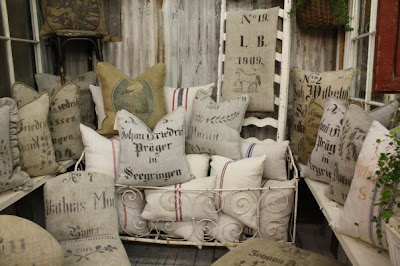
Since my last post on Antique Grain Sacks, I have had an overwhelming amount of emails and interest in antique linens. Like all antiques there are levels of uniqueness, rarity and therefore of value. Most of the textiles I featured were plain striped sacks, but I have learned about another world of textiles: the very high end, elite textiles! These are printed grain sacks with writing and even more unique, those with pictures of wreaths, horses or crowns. These grain sacks are quite rare and, of course, very valuable. Owning one is like investing in a precious piece of art, one with a unique history.

Since the mention in The Washington Post, I had the great personal fortune to connect and speak with Textile Artist and Interior Designer, Kymberley Fraser of 3 Fine Grains. Kymberley collects, restores and re fabricates these very rare vintage sacks into "Authenticated Originals". Kymberley explained that she has always had a passion for antique textiles, and as a result she has developed a true respect for these linens as historical antiques. She believes if her well preserved pieces could speak; they could tell amazing stories of people's lives in times past. Like any other reputable and knowledgeable dealer, Kymberley has been collecting for many years. She recently began designing these linens in to pillows and reupholstering them on to classic antique chairs and ottomans to create one of kind pieces of furniture.
Let's review some attributes of these rare linens and how to tell if its an original.

These textiles, on average are 100 years old. All are hand woven, made of pure hemp linen. The weave is generally a herringbone. Most originals have darns, or hand patched holes and staining. The chairs above both have pictures, as well as printing, which add to their value.

The horse symbol is very rare. This vanity or desk chair is made out of a very rare German grain sack from 1907. Notice the patching on the bottom right corner. Sadly this item is already sold, but Kymberley will do custom orders.

These rare Horse sacks above are stamped on both sides and are from 1909. Kymberley was able to locate four of these very rare sacks; wouldn't they look wonderful upholstered or slipcovered for dining room chairs!



Here are examples of Laurel Wreaths from 1862, 1869 and 1898. The addition of the wreath adds significantly to the value of the piece. Notice the wonderful nubby weave and patching on them.


Extremely sought after and collectible are the very rare "Crown" sacks. This one, from 1862, was made into an ottoman. It's so charming, with nail heads around the base and ebony turned legs.


Here are some lovely examples of Laurel Wreathing and Vines. I especially love the chair - what a wonderful piece of history beautifully preserved.

Here is a kidney sized pillow from 1902 with a unique nautical print. Wouldn't this look fabulous in beach house?


These are examples of Puy Lentil sacks from the early 1900's made from jute. The Train sack is from Friesland which is a province in the Netherlands, while the Stork sack is from France. Rare and beautiful!

Above are two extremely rare sacks. Not very often are two sacks from the same farmer at the same time, still preserved and available. These are #2 and #5 - If you see two sacks that are identical beware! Sadly, like any other hot antique, fakes are starting to enter this market.
Kymberley guarantees that the integrity of her textiles and the printing are original and none are modern reproductions. When you are buying these special printed antiques sacks you need to ask, is it the sack that is antique or is the printing a modern reproduction on an antique sack? Here are some tips from Kymberley: Check that the sacks are not too perfect, have imperfections in the weave, or patching; also make sure the printing is not too bold or uniform. All are signs of reproductions.

Another very rare sack from Kimberley has printing and stripes. This one is original, but you may start to see this type of fake, as well. They are taking real antique stripe sacks, which are inexpensive in comparison, and stamping them with modern printing in an antique style. So buyer beware and buy only from reputable dealers.

Of course these textiles are "green" - 100% pure organic hemp linen and tar based printing, made before "green" was even a concern or "in vogue". Kymberley's pillows range in price from $250 to $500 dollars. Her furniture and pillows are available in CA at Bungalow Antiques in Agoura Hills, and on line. Thanks Kymberley for giving us a lesson in these rare and timeless linens!


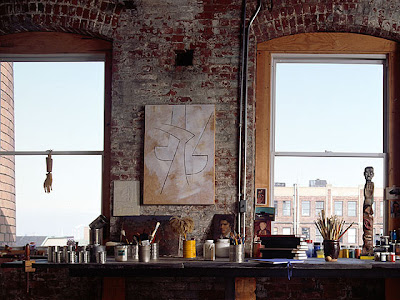
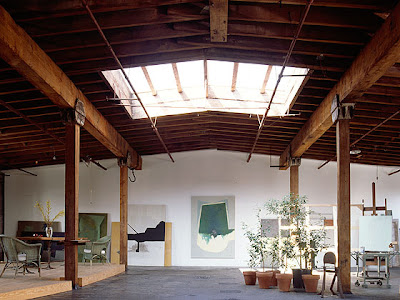

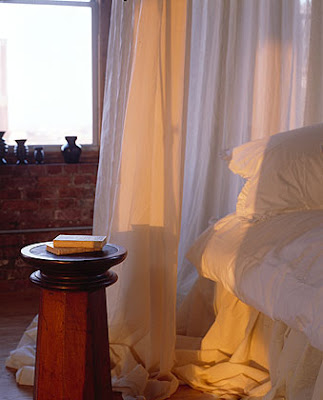 I love the spare furnishings - what a wonderfully unique side table.
I love the spare furnishings - what a wonderfully unique side table.













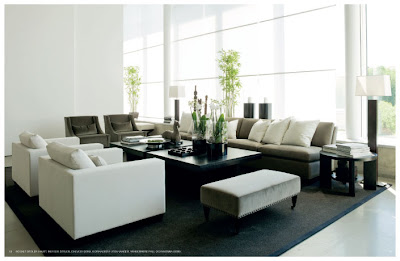 They offer wonderful lines of furniture in several styles for classic, beach and modern interiors.
They offer wonderful lines of furniture in several styles for classic, beach and modern interiors.
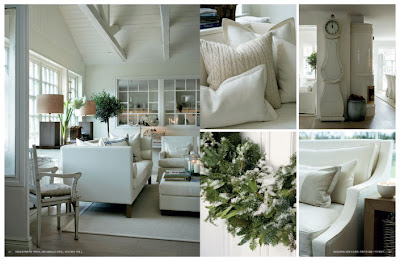
 The above photos represent more of their classic line. I really love the fitted slipcovers and textured, linen fabrics. The mix of chairs and the bench around the trestle cross dining table is an all time favorite.
The above photos represent more of their classic line. I really love the fitted slipcovers and textured, linen fabrics. The mix of chairs and the bench around the trestle cross dining table is an all time favorite.
 The above photos show a more beachy feeling. They also carry an outdoor furniture line.
The above photos show a more beachy feeling. They also carry an outdoor furniture line.

 Above is the more modern side of Slettvoll. Notice the diffrent mix of textures in the room above.
Above is the more modern side of Slettvoll. Notice the diffrent mix of textures in the room above. 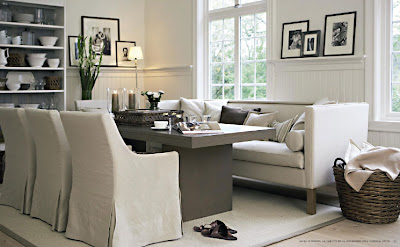 Wonderful! I just love this dining room. I adore the slip-covered chairs -the lines are slimmer with a modern feeling. Brooke Gianetti at Velvet and Linen has designed furniture with a similar feel and offers it for sale in her store, Gianetti Home. (
Wonderful! I just love this dining room. I adore the slip-covered chairs -the lines are slimmer with a modern feeling. Brooke Gianetti at Velvet and Linen has designed furniture with a similar feel and offers it for sale in her store, Gianetti Home. (


 Modern Hennie designs
Modern Hennie designs Since my last post on Antique Grain Sacks, I have had an overwhelming amount of emails and interest in antique linens. Like all antiques there are levels of uniqueness, rarity and therefore of value. Most of the textiles I featured were plain striped sacks, but I have learned about another world of textiles: the very high end, elite textiles! These are printed grain sacks with writing and even more unique, those with pictures of wreaths, horses or crowns. These grain sacks are quite rare and, of course, very valuable. Owning one is like investing in a precious piece of art, one with a unique history.
Since my last post on Antique Grain Sacks, I have had an overwhelming amount of emails and interest in antique linens. Like all antiques there are levels of uniqueness, rarity and therefore of value. Most of the textiles I featured were plain striped sacks, but I have learned about another world of textiles: the very high end, elite textiles! These are printed grain sacks with writing and even more unique, those with pictures of wreaths, horses or crowns. These grain sacks are quite rare and, of course, very valuable. Owning one is like investing in a precious piece of art, one with a unique history. Since the mention in The Washington Post, I had the great personal fortune to connect and speak with Textile Artist and Interior Designer, Kymberley Fraser of 3 Fine Grains. Kymberley collects, restores and re fabricates these very rare vintage sacks into "Authenticated Originals". Kymberley explained that she has always had a passion for antique textiles, and as a result she has developed a true respect for these linens as historical antiques. She believes if her well preserved pieces could speak; they could tell amazing stories of people's lives in times past. Like any other reputable and knowledgeable dealer, Kymberley has been collecting for many years. She recently began designing these linens in to pillows and reupholstering them on to classic antique chairs and ottomans to create one of kind pieces of furniture.
Since the mention in The Washington Post, I had the great personal fortune to connect and speak with Textile Artist and Interior Designer, Kymberley Fraser of 3 Fine Grains. Kymberley collects, restores and re fabricates these very rare vintage sacks into "Authenticated Originals". Kymberley explained that she has always had a passion for antique textiles, and as a result she has developed a true respect for these linens as historical antiques. She believes if her well preserved pieces could speak; they could tell amazing stories of people's lives in times past. Like any other reputable and knowledgeable dealer, Kymberley has been collecting for many years. She recently began designing these linens in to pillows and reupholstering them on to classic antique chairs and ottomans to create one of kind pieces of furniture. These textiles, on average are 100 years old. All are hand woven, made of pure hemp linen. The weave is generally a herringbone. Most originals have darns, or hand patched holes and staining. The chairs above both have pictures, as well as printing, which add to their value.
These textiles, on average are 100 years old. All are hand woven, made of pure hemp linen. The weave is generally a herringbone. Most originals have darns, or hand patched holes and staining. The chairs above both have pictures, as well as printing, which add to their value. The horse symbol is very rare. This vanity or desk chair is made out of a very rare German grain sack from 1907. Notice the patching on the bottom right corner. Sadly this item is already sold, but Kymberley will do custom orders.
The horse symbol is very rare. This vanity or desk chair is made out of a very rare German grain sack from 1907. Notice the patching on the bottom right corner. Sadly this item is already sold, but Kymberley will do custom orders. These rare Horse sacks above are stamped on both sides and are from 1909. Kymberley was able to locate four of these very rare sacks; wouldn't they look wonderful upholstered or slipcovered for dining room chairs!
These rare Horse sacks above are stamped on both sides and are from 1909. Kymberley was able to locate four of these very rare sacks; wouldn't they look wonderful upholstered or slipcovered for dining room chairs!

 Here are examples of Laurel Wreaths from 1862, 1869 and 1898. The addition of the wreath adds significantly to the value of the piece. Notice the wonderful nubby weave and patching on them.
Here are examples of Laurel Wreaths from 1862, 1869 and 1898. The addition of the wreath adds significantly to the value of the piece. Notice the wonderful nubby weave and patching on them. 


 Here are some lovely examples of Laurel Wreathing and Vines. I especially love the chair - what a wonderful piece of history beautifully preserved.
Here are some lovely examples of Laurel Wreathing and Vines. I especially love the chair - what a wonderful piece of history beautifully preserved.  Here is a kidney sized pillow from 1902 with a unique nautical print. Wouldn't this look fabulous in beach house?
Here is a kidney sized pillow from 1902 with a unique nautical print. Wouldn't this look fabulous in beach house? 
 These are examples of Puy Lentil sacks from the early 1900's made from jute. The Train sack is from Friesland which is a province in the Netherlands, while the Stork sack is from France. Rare and beautiful!
These are examples of Puy Lentil sacks from the early 1900's made from jute. The Train sack is from Friesland which is a province in the Netherlands, while the Stork sack is from France. Rare and beautiful! Above are two extremely rare sacks. Not very often are two sacks from the same farmer at the same time, still preserved and available. These are #2 and #5 - If you see two sacks that are identical beware! Sadly, like any other hot antique, fakes are starting to enter this market.
Above are two extremely rare sacks. Not very often are two sacks from the same farmer at the same time, still preserved and available. These are #2 and #5 - If you see two sacks that are identical beware! Sadly, like any other hot antique, fakes are starting to enter this market. Another very rare sack from Kimberley has printing and stripes. This one is original, but you may start to see this type of fake, as well. They are taking real antique stripe sacks, which are inexpensive in comparison, and stamping them with modern printing in an antique style. So buyer beware and buy only from reputable dealers.
Another very rare sack from Kimberley has printing and stripes. This one is original, but you may start to see this type of fake, as well. They are taking real antique stripe sacks, which are inexpensive in comparison, and stamping them with modern printing in an antique style. So buyer beware and buy only from reputable dealers.  Of course these textiles are "green" - 100% pure organic hemp linen and tar based printing, made before "green" was even a concern or "in vogue". Kymberley's pillows range in price from $250 to $500 dollars. Her furniture and pillows are available in CA at Bungalow Antiques in Agoura Hills, and on line. Thanks Kymberley for giving us a lesson in these rare and timeless linens!
Of course these textiles are "green" - 100% pure organic hemp linen and tar based printing, made before "green" was even a concern or "in vogue". Kymberley's pillows range in price from $250 to $500 dollars. Her furniture and pillows are available in CA at Bungalow Antiques in Agoura Hills, and on line. Thanks Kymberley for giving us a lesson in these rare and timeless linens!